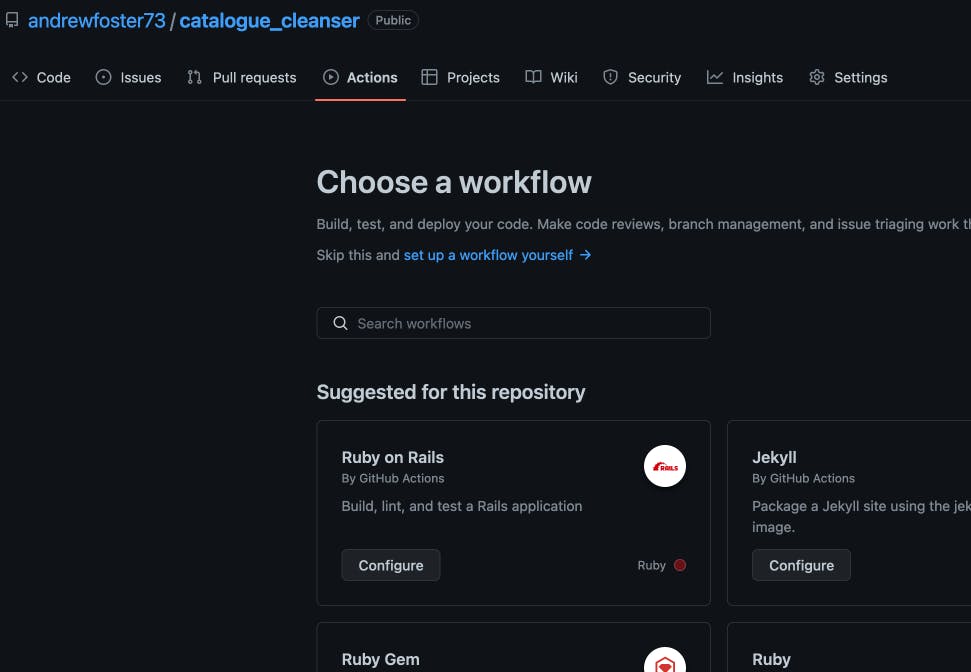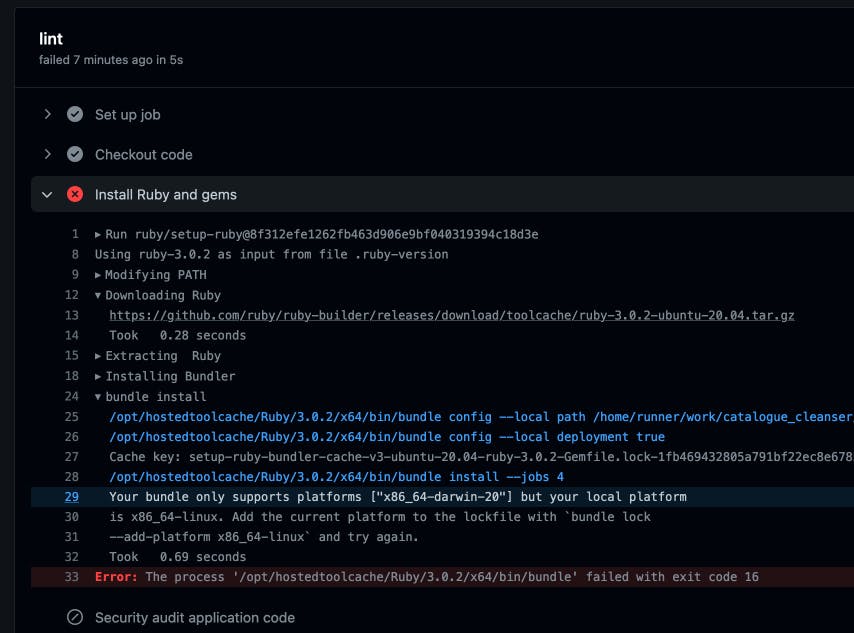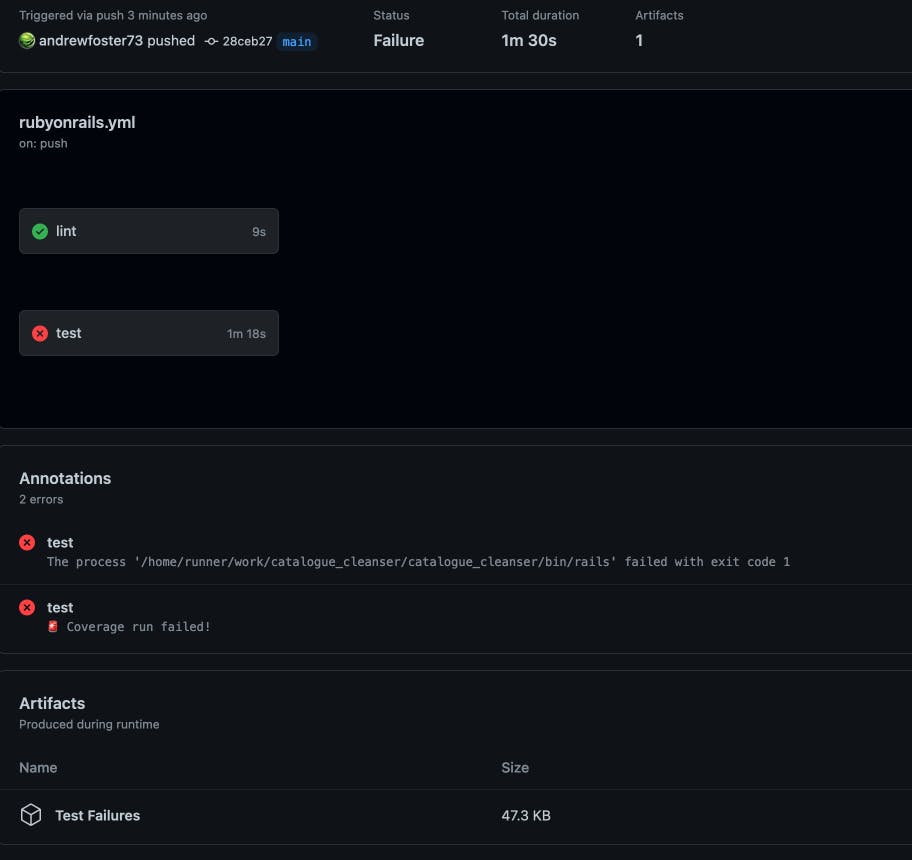Testing and Continuous Integration
Part 5 of building a Rails 7 application
Previously for CI/CD I have used CircleCI, TravisCI and other platforms (like Bamboo). For this project I will use GitHub Actions to see if that can do everything I need.
In the Actions tab of my GitHub repository is the option to add a new workflow. There is a default set up for Ruby on Rails so I'll start with that.

I've tweaked the file that is generated so that minitest is run in the tests job and the results of the SimpleCov code coverage are uploaded to CodeClimate. It is also using a test environment I created in GitHub with a single secret for the CC_TEST_REPORTER_ID.
.github/workflows/rubyonrails.yml
# This workflow uses actions that are not certified by GitHub. They are
# provided by a third-party and are governed by separate terms of service,
# privacy policy, and support documentation.
#
# This workflow will install a prebuilt Ruby version, install dependencies, and
# run tests and linters.
name: "CI"
on:
push:
branches: [ "main" ]
pull_request:
branches: [ "main" ]
jobs:
test:
runs-on: ubuntu-latest
environment: test
services:
postgres:
image: postgres:14-alpine
ports:
- "5432:5432"
env:
POSTGRES_DB: rails_test
POSTGRES_USER: rails
POSTGRES_PASSWORD: password
env:
RAILS_ENV: test
DATABASE_URL: "postgres://rails:password@localhost:5432/rails_test"
steps:
- name: Checkout code
uses: actions/checkout@v3
# Add or replace dependency steps here
- name: Install Ruby and gems
uses: ruby/setup-ruby@8f312efe1262fb463d906e9bf040319394c18d3e # v1.92
with:
bundler-cache: true
- name: Set up Chrome
uses: browser-actions/setup-chrome@latest
with:
chrome-version: stable
- name: Download chrome driver
uses: nanasess/setup-chromedriver@v1.0.7
- name: Launch chrome driver
run: |
export DISPLAY=:99
chromedriver --url-base=/wd/hub &
sudo Xvfb -ac :99 -screen 0 1280x1024x24 > /dev/null 2>&1 & # optional
# Add or replace database setup steps here
- name: Set up database schema
run: bin/rails db:schema:load
# Add or replace test runners here
- name: Run Tests and Upload Code Coverage
uses: paambaati/codeclimate-action@v3.0.0
env:
CC_TEST_REPORTER_ID: ${{ secrets.CC_TEST_REPORTER_ID }}
with:
coverageCommand: bin/rails test:all
debug: true
- name: Upload test failures
uses: actions/upload-artifact@v3
if: failure()
with:
name: Test Failures
path: /home/runner/work/catalogue_cleanser/catalogue_cleanser/tmp/screenshots
retention-days: 5
lint:
runs-on: ubuntu-latest
steps:
- name: Checkout code
uses: actions/checkout@v3
- name: Install Ruby and gems
uses: ruby/setup-ruby@8f312efe1262fb463d906e9bf040319394c18d3e # v1.92
with:
bundler-cache: true
# Add or replace any other lints here
- name: Lint Ruby files
run: bundle exec rubocop --parallel
On an initial run this has failed though with the following error. Luckily it has the appropriate instructions for fixing it.

Gemfile.lock
PLATFORMS
x86_64-darwin-20
% bundle lock --add-platform x86_64-linux
% bundle lock --add-platform ruby
Gemfile.lock
PLATFORMS
ruby
x86_64-darwin-20
x86_64-linux
I also needed to add the following section to the .github/workflows/rubyonrails.yml file so that Selenium could launch Chrome to run the system tests in the scaffolded application.
- name: Set up Chrome
uses: browser-actions/setup-chrome@latest
with:
chrome-version: stable
- name: Download chrome driver
uses: nanasess/setup-chromedriver@v1.0.7
- name: Launch chrome driver
run: |
export DISPLAY=:99
chromedriver --url-base=/wd/hub &
sudo Xvfb -ac :99 -screen 0 1280x1024x24 > /dev/null 2>&1 & # optional
The other change was to application_system_test_case.rb to indicate I want the headless version of Chrome.
class ApplicationSystemTestCase < ActionDispatch::SystemTestCase
driven_by :selenium, using: :headless_chrome, screen_size: [1400, 1400]
end
In order to get the code coverage uploaded to CodeClimate the following needs to be added to the .github/workflows/rubyonrails.yml file.
- name: Run Tests and Upload Code Coverage
uses: paambaati/codeclimate-action@v3.0.0
env:
CC_TEST_REPORTER_ID: ${{ secrets.CC_TEST_REPORTER_ID }}
with:
coverageCommand: bin/rails test:all
debug: true
The .simplecov file is where SimpleCov configuration is placed. The filter The minimum coverage is what percentage of lines are covered before considered passing. 90% is going to be my goal here but at the moment I'm only getting to around 87% due to some controller responses not being tested yet.
SimpleCov.start :rails do
minimum_coverage 80
maximum_coverage_drop 2
end
And in the test_helper.rb file I tell SimpleCov to execute by requiring 'simplecov'. It also appears that SimpleCov does not like the new parallel testing setting so that needs to be disabled.
class ActiveSupport::TestCase
# Run tests in parallel with specified workers
# DOES NOT WORK WITH SimpleCov
# parallelize(workers: :number_of_processors)
# Setup all fixtures in test/fixtures/*.yml for all tests in alphabetical order.
fixtures :all
# Add more helper methods to be used by all tests here...
end
If there are failures in the system tests these will produce screenshots to assist with troubleshooting what the problem is. By adding this step to the .github/workflows/rubyonrails.yml file those screenshots will be saved as an artifact that can be downloaded.
- name: Upload test failures
uses: actions/upload-artifact@v3
if: failure()
with:
name: Test Failures
path: /home/runner/work/catalogue_cleanser/catalogue_cleanser/tmp/screenshots
retention-days: 5
Here is a screenshot of a failed run with a link to the artifact.

I can also add the status of the workflow to the README.md so it is clear whether all the tests and linting are passing currently or not. The test coverage statistic is now also correctly returning the coverage result.


Useful links:
docs.github.com/en/actions/deployment/targe..
docs.github.com/en/actions/security-guides/..
github.com/actions/upload-artifact

